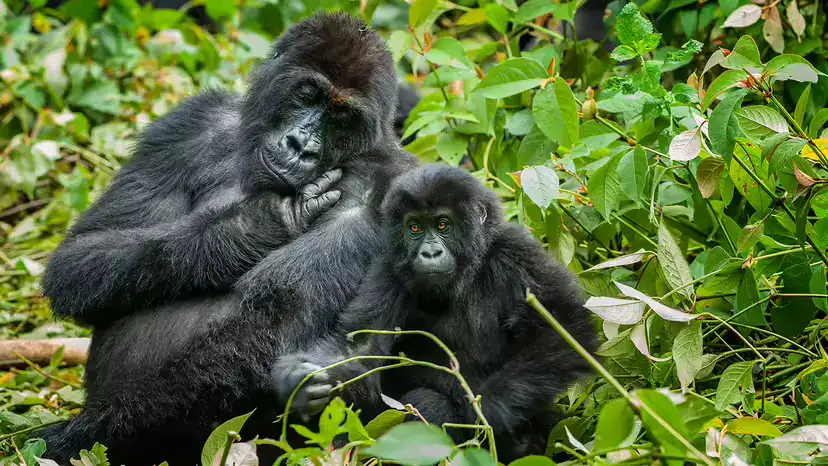Key Takeaways
Biggest gorilla by body mass; endemic to the eastern Democratic Republic of the Congo (DRC), mainly lowland and sub-montane rainforest.
Status: Critically Endangered with fewer than ~5,000 left; numbers have fallen sharply over recent decades.
Main threats: Industrial and artisanal deforestation/mining, poaching for bushmeat, civil insecurity, disease, and habitat fragmentation.
What helps: Community co-managed reserves, anti-poaching patrols, protected-area financing, conflict-sensitive ranger programs, and livelihood alternatives that reduce hunting pressure.

Taxonomy: Eastern gorilla → subspecies Eastern Lowland (Grauer’s) gorilla; the other eastern subspecies is the mountain gorilla.
Size & build: The heaviest gorilla; very stocky torso, immense hands/feet, shorter muzzle than mountain gorillas. Adult silverbacks develop the characteristic grey saddle on the back.
Range (current): Patchy strongholds in eastern DRC, including and around Kahuzi-Biega NP, Maiko NP, and adjacent community forests. Historic range was much larger.
Elevation band: Primarily lowland rainforest but reaches into foothill/ sub-montane zones where forests persist.
Fifty years ago, suitable habitat covered roughly 20,000+ km²; today it is closer to 12,000 km² and highly fragmented. Conversion to fields, logging roads, and mining corridors has splintered forest blocks, isolating family groups and increasing human contact. Even inside national parks, encroachment and insecurity can disrupt daily routines such as feeding, travel, and nesting.
Key pressures on habitat
Forest conversion: smallholder agriculture, charcoal production, cattle encroachment.
Resource extraction: timber and artisanal/industrial mining (gold, coltan, cassiterite).
Energy concessions: oil/gas surveys create roads and noise, opening forests to further incursions.
Eastern lowland gorillas are highly social and live in family troops led by a dominant silverback.
Group structure: 1 silverback + several females + their dependent young; group size is variable (often 6–20, occasionally ~30).
Daily rhythm: Forage in the morning/late afternoon; make new leaf nests each evening.
Communication: A rich repertoire—grunts, hoots, belches, chest-beats, postures and displays—to signal reassurance, warning, or dominance.
Reproduction: Single infant after ~8.5-month gestation. Infants ride and sleep with the mother; weaning typically at 3–4 years; inter-birth interval is long, so population recovery is slow.
Primarily folivorous–frugivorous: fruits (when available), young leaves, pith, shoots, stems, bark, plus occasional ants/termites for protein. Seasonal fruit pulses can shift ranging patterns; in lean periods they rely more on fibrous vegetation. Moisture from plants means they rarely drink directly from streams.
Bushmeat hunting & snares
Expanding populations around forests and mining camps increase demand for protein. Wire snares and opportunistic shooting remove adults and cripple juveniles; the loss of even a few breeding silverbacks heavily impacts group stability.
Habitat loss & fragmentation
Logging roads and mine access tracks carve forests into islands, raising human–gorilla encounters and easing access for poachers.
Civil insecurity
Armed groups and illicit economies complicate patrolling, push communities deeper into forests, and heighten risks for wildlife rangers.
Disease risk
Close genetic relatedness to humans means respiratory pathogens and other infections can be severe. Tourism or research without strict hygiene protocols can amplify transmission.
Community-based reserves & co-management
Buffer zones where local communities secure tenure and co-govern forests. Agreements often include no-hunting zones, sustainable resource extraction rules, and benefit-sharing from legal value chains (e.g., cacao, coffee, honey).
Professionalized ranger networks
Training, equipment, conflict-sensitive patrol planning, and fair compensation reduce risk and improve snare removal, encounter reporting, and evidence collection.
Anti-poaching & market measures
Targeted patrols on known snare lines; support for protein alternatives (fish ponds, small livestock), and law-enforcement on bushmeat trafficking routes.
Mining/energy safeguards
No-go zones in core habitat; independent impact monitoring; strict control of road building, worker camps, and waste; closure/rehab of illegal pits.
Health protocols (One Health)
Masking, minimum distances, group-size caps, and quarantine for staff/visitors; vaccination of frontline personnel; community clinics to reduce pathogen load spilling into wildlife.
Long-term monitoring
Recce/camera traps, nest-count transects, genetic dung sampling to track population trends, gene flow, and priority corridors for connectivity.
Nesting behavior: New nests nightly, from ground to low trees.
Feeding signs: Stripped pith, chewed bark, fruit leftovers under feeding trees.
Travel corridors: Reused trails between feeding sites—critical targets for corridor protection.
Why are Eastern lowland gorillas larger than other gorillas?
They evolved in resource-rich lowland forests, enabling larger body mass—useful for processing fibrous plants and defending family groups.
How do they communicate?
Through vocal calls (grunts/hoots), chest-beating, facial expressions, and postures that reinforce hierarchy and reduce conflict.
What’s the single most impactful action for conservation?
Protecting large, connected forest blocks while removing snares and creating viable livelihoods that reduce reliance on bushmeat.
animal tags: eastern lowland gorilla
We created this article in conjunction with AI technology, then made sure it was fact-checked and edited by a Animals Top editor.